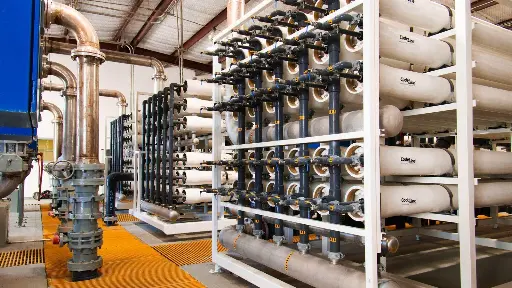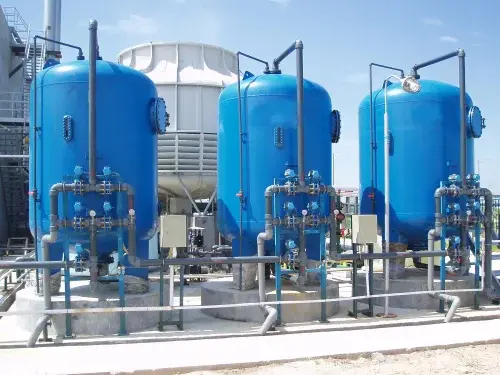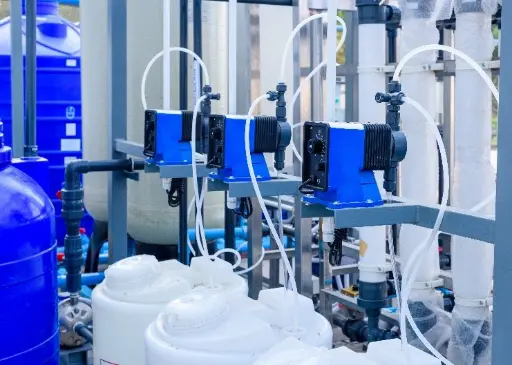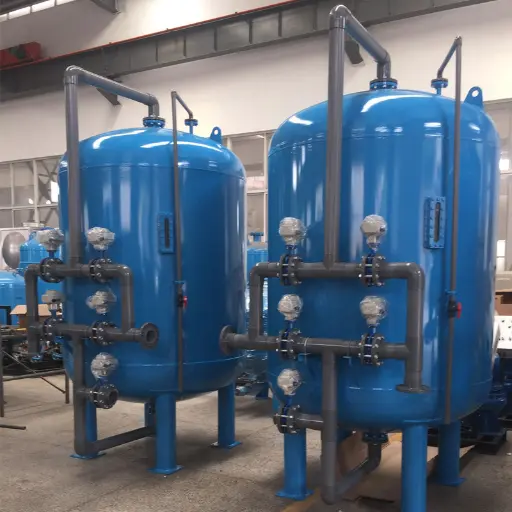Cooling Tower Water Treatment
Cooling towers are ubiquitous across the energy and chemical and petroleum industries because they are the primary devices that reject process heat from condensers, exchangers, and air‑conditioning systems. Within these industries the water that circulates through these towers is continuously recycled and exposed to airborne contaminants, heat, and chemical additives. Unless this circulating stream is properly treated, impurities concentrate by evaporation and cause deposits, corrosion, or microbiological growth that reduce the tower’s thermal efficiency and threaten equipment integrity. Cooling tower water treatment is the discipline of conditioning make‑up and recirculating water to remove impurities, control scale and corrosion, and inhibit biological organisms so that heat is transferred efficiently and components remain protected. This definition conveys a proactive process that intersects with chemistry, microbiology, and mechanical engineering. Operators in thermal power plants and petrochemical facilities integrate various pretreatment methods, dosing programs, and monitoring tools to maintain water quality within acceptable ranges and to sustain the cycles of concentration that drive water conservation. The complexities of the systems vary depending on raw water source, cooling load, and environmental regulations, yet the fundamental objective of managing purity and reducing fouling is consistent across energy conversion and chemical production sites. By understanding the interplay of evaporative losses, blowdown, and chemical equilibrium, engineers can tailor programs that minimize operational risks while conserving resources. A thoughtful program also reduces the likelihood of hazardous biological organisms such as Legionella, which can proliferate in warm, nutrient‑rich cooling water. The science behind the treatment is rooted in well‑characterised reactions such as precipitation of calcium carbonate, oxidation of biofilms, and corrosion inhibition via film‑forming inhibitors.
Effective treatment delivers tangible business value for power generation, refinery, and petrochemical operations. When surface deposits form on heat exchanger tubes, the thermal conductivity of those surfaces drops, and more fuel or electricity is required to achieve the same cooling effect. Scale comprised of calcium carbonate, calcium phosphate, or silica acts as an insulator and forces chillers and condensers to work harder, increasing energy consumption and greenhouse gas emissions. Corrosion dissolves metal surfaces, leaks process fluids, and introduces particulate contamination into downstream equipment, leading to unplanned outages. Biofouling is another risk that emerges when nutrients, warm temperatures, and stagnant areas coincide; bacteria and algae produce extracellular polymers that block orifices, harbor pathogens, and accelerate corrosion through metabolite production. Cooling tower water treatment programmes mitigate these risks by reducing dissolved solids through controlled blowdown, replenishing water that meets quality specifications, and employing inhibitors and dispersants to keep ions in solution. The ability to operate at higher cycles of concentration—essentially recirculating the water more times before discharge—directly translates to reduced consumption of make‑up water and lower wastewater volumes. This matters in energy and chemical sectors where large heat loads mean towers can evaporate hundreds of cubic metres per hour. The economic benefits include reduced water purchase costs, lower chemical consumption due to optimisation, extended equipment life, and avoidance of regulatory penalties associated with environmental discharge. Effective treatment is also a prerequisite for meeting workplace safety and public health obligations, particularly with respect to Legionella control. In summary, the business case for robust cooling tower water treatment is compelling when viewed through the lenses of energy efficiency, asset integrity, resource conservation, and compliance.
Related Products for Cooling Tower Water Treatment

Reverse Osmosis
Semi‑permeable polyamide membranes operating at moderate pressures reject up to ninety‑nine percent of dissolved salts, silica, and organic molecules, producing low‑conductivity permeate suitable for high‑purity make‑up water. Reverse osmosis units are common in facilities where raw water salinity is high, such as coastal refineries that use brackish sources. The permeate reduces scaling potential and allows towers to run at higher cycles of concentration, while the concentrate is managed separately.

Multimedia Filters
Pressure sand or multimedia filters remove suspended solids and debris from make‑up water, preventing these particles from fouling heat exchanger surfaces and acting as nuclei for scale formation. In many power plants and refineries the make‑up water is sourced from rivers or wells that carry turbidity and silt; a properly sized filter reduces turbidity to below 5 NTU and protects downstream softeners and membrane systems. These filters operate continuously at flow rates matching tower demand and are backwashed periodically to discharge accumulated solids.

Chemical Dosing Systems
Automated dosing pumps and controllers introduce corrosion inhibitors, scale inhibitors, dispersants, and oxidising or non‑oxidising biocides into the recirculating water at controlled rates. Feedback from conductivity and pH sensors ensures that chemical addition is proportional to system demand and maintains setpoints. These systems enable precise management of inhibitor concentrations, minimising chemical waste and preventing under‑ or over‑treatment, which is critical for protecting carbon steel, stainless steel, and copper alloys common in heat exchangers.

Water Softener
Cation resin beds in sodium form exchange hardness ions such as calcium and magnesium for sodium, reducing hardness to near zero and eliminating the primary precursors for scale. Softeners are often the first pretreatment step after filtration when make‑up water originates from municipal or surface sources with moderate hardness. Regeneration cycles use saturated brine to restore exchange capacity, and the softened effluent feeds directly to the cooling tower or additional polishing units.
Properly integrating these technologies into cooling tower water treatment is vital because each addresses different aspects of water quality. Filtration safeguards downstream units and reduces turbidity so that chemicals can interact effectively with dissolved species. Reverse osmosis or softening lowers dissolved solids and hardness, enabling operators to raise cycles of concentration and conserve water without scaling. Automated chemical feed ensures that inhibitors and biocides are dosed accurately in response to changing load conditions, preventing corrosion and biofouling while avoiding chemical overdose. Ultraviolet disinfection mitigates microbial populations and helps maintain sanitary conditions, which is increasingly important in jurisdictions with strict legionellosis regulations. Side‑stream filtration supplements the overall programme by continuously polishing the circulating water, limiting particle buildup and maintaining clear tube surfaces. In combination, these systems allow energy, chemical, and petroleum facilities to maintain efficient and compliant operations under varying feed water qualities and process demands.
Key Water‑Quality Parameters Monitored
Maintaining stable water chemistry in cooling towers requires continuous or frequent measurement of parameters that influence scale, corrosion, and microbial growth. Conductivity and total dissolved solids indicate the concentration of ions in the recirculating water and thus reflect the cycles of concentration being achieved. Operators aim to keep conductivity below levels that would precipitate sparingly soluble salts; in typical power plant systems this might be controlled around 1 500 to 2 000 µS/cm when a full chemical programme is used. pH affects the solubility of calcium carbonate and the effectiveness of corrosion inhibitors; values are commonly maintained between 7.0 and 8.5 to balance scaling and corrosion tendencies. Total alkalinity, expressed as mg/L as CaCO₃, is another critical metric because it buffers pH and contributes to the Langelier Saturation Index (LSI); if alkalinity becomes too high, scaling risk increases even when pH is moderate. Calcium hardness and magnesium hardness represent the concentration of divalent cations that readily form scale; controlling these ions through softening or limiting cycles prevents deposition on heat transfer surfaces. Silica concentration is monitored because silica can form hard, glassy scales at high temperatures that are difficult to remove; typical guidelines limit silica to 100 mg/L in tower water. Chloride and sulfate ions are associated with corrosivity, particularly for stainless steels and copper alloys; chloride is usually kept below 250 mg/L and sulfate below 500 mg/L to avoid pitting. Dissolved oxygen levels and oxidation–reduction potential provide insight into the corrosion potential and biocidal activity of the water; low oxygen suggests reducing conditions that may foster anaerobic bacteria, whereas high ORP indicates effective oxidising biocide residuals. Microbiological counts, measured through dip slides, adenosine triphosphate (ATP) tests, or plate counts, help assess the need for biocide dosing and validate that control measures are working. The presence of biofilm can be inferred from differential pressure across side‑stream filters or from increases in approach temperatures on heat exchangers, which signals that monitoring cannot rely solely on bulk water tests.
Instrumentation plays a central role in capturing these parameters. Conductivity probes and controllers adjust blowdown valves automatically to maintain cycles within target limits, while pH sensors link to acid or caustic feed pumps to correct deviations. Online hardness analysers or periodic titrations inform softener regeneration schedules and guide adjustments to inhibitor doses. Silica monitors are used where high silica raw water enters the system, such as in geothermal power plants; readings above typical setpoints trigger adjustments to cycle limits or require use of dispersants. Chlorine residual analysers, oxidation–reduction potential sensors, and ORP controllers are employed to control oxidising biocide feeds and verify that residuals meet disinfection goals without exceeding discharge permits. Microbiological monitoring may involve weekly dip slide tests or online biofilm probes that measure heat flux changes; when counts exceed thresholds, operators adjust biocide strategy or clean the system. Finally, corrosion coupons and electronic corrosion rate probes provide lagging and real‑time indications of metal loss, informing inhibitor dosing and material selection.
| Parameter | Typical Range | Control Method |
| Conductivity | 1 000–2 000 µS/cm | Adjust blowdown via conductivity controller and blowdown valve |
| pH | 7.0–8.5 | Dose acid or caustic to correct deviations and stabilise alkalinity |
| Total Alkalinity | 100–1 000 mg/L as CaCO₃ | Control cycles of concentration and add acid to reduce alkalinity |
| Calcium Hardness | 50–1 000 mg/L as CaCO₃ | Soften make‑up water and add scale inhibitors |
| Silica | 10–100 mg/L | Limit cycles, apply dispersants, or reduce silica through RO |
| Chloride | < 250 mg/L | Manage blowdown and avoid seawater intrusion into intake |
| Sulfate | < 500 mg/L | Control cycles and monitor for corrosion impact |
| Microbial Count | < 10⁴ cfu/mL or < 10³ RLU (ATP) | Adjust biocide dosing and perform mechanical cleaning |
| ORP / Chlorine Residual | 600–800 mV ORP / 0.5–1.0 mg/L free chlorine | Control oxidising biocide feed and verify residuals |
| Dissolved Oxygen | 2–8 mg/L | Introduce nitrogen blanketing in closed sections or apply oxygen scavengers |
Design & Implementation Considerations
Designing and implementing a cooling tower water treatment programme in energy and chemical facilities demands a holistic understanding of heat load, water quality, materials of construction, and regulatory context. Engineers begin by characterising the make‑up water source; river water, well water, desalinated water, or municipal supply each present unique challenges in terms of suspended solids, hardness, salinity, and organic load. The selection of pretreatment equipment—be it media filtration, cartridge filtration, softening, or membrane desalination—depends on these characteristics as well as on the required cycles of concentration. Systems that use brackish water, for instance, may rely on reverse osmosis to remove excess salts so that towers can operate at three or more cycles without exceeding limits for conductivity or chloride. Plant designers also calculate thermal duty and evaporative loss to size the tower, pumps, and piping; these calculations must account for seasonal ambient conditions in Istanbul or other local climates that influence evaporation. In addition, designers assess the metallurgy of heat exchangers and tower hardware, selecting materials such as carbon steel, stainless steel, titanium, or fibreglass that resist corrosion under expected water chemistries. When high chloride or low pH is anticipated, corrosion‑resistant materials are justified despite higher initial cost because they reduce long‑term maintenance and outage risks.
Regulatory and standards compliance is woven into the implementation process. Facilities adhere to building codes, water discharge permits, and ASME consensus guidelines that set minimum design and operating criteria for boiler and cooling systems. Environmental protection regulations, including local discharge limits on total dissolved solids, free residual chlorine, and temperature, shape the allowable concentration factors and influence chemical selection. Occupational health guidelines relevant to Legionella control align with ISO 45001 health and safety frameworks, prompting designers to incorporate drift eliminators, side‑stream disinfection, and sampling points. Quality management systems based on ISO 9001 or ISO 14001 require documentation, calibration of instruments, and periodic review of treatment efficacy. During commissioning, engineers verify correct installation of chemical feed pumps, controllers, and sensors, ensuring that they respond promptly to changes in water chemistry. A risk assessment may be performed to evaluate potential contamination points and to plan for redundancy in critical components such as dual dosing pumps or bypass capabilities. Overall, successful implementation balances technical performance, compliance, and cost, with a strong emphasis on adapting the design to the facility’s operating schedule, process requirements, and environmental responsibilities.
Operation & Maintenance
Operating a cooling tower water treatment system involves continuous observation, adjustment, and record‑keeping to maintain water quality within specified limits. Operators perform daily checks of conductivity, pH, and temperature, manually verifying automated controller readings and noting any deviation from setpoints. Weekly tasks often include measuring hardness, alkalinity, and inhibitor residuals with portable test kits and adjusting chemical dosing rates accordingly. Biocide programmes typically involve alternating oxidising and non‑oxidising biocides; oxidisers like chlorine or bromine are applied continuously or intermittently, while non‑oxidisers such as glutaraldehyde or isothiazolin are dosed monthly to prevent microbial resistance. Blowdown control is critical; an automatic valve linked to the conductivity controller opens to discharge water when conductivity exceeds the setpoint, maintaining cycles without manual intervention. Operators also monitor makeup water flow meters and evaporation estimates to detect leaks, drift, or overflows, which may indicate issues with float valves or drift eliminators. Routine visual inspections of the tower basin, fill media, and drift eliminators help identify accumulation of sludge or biological slime; any deposits are removed during scheduled cleaning to restore flow and mitigate microbiological risk.
Preventive maintenance extends beyond chemical management. Mechanical components such as fans, motors, gearboxes, and pumps require lubrication, vibration analysis, and alignment checks at prescribed intervals to prevent mechanical failures that could disrupt cooling. Heat exchanger bundles are inspected and cleaned annually or more frequently if fouling indicators show reduced heat transfer efficiency; cleaning methods may include high‑pressure water jetting, chemical descaling, or hydro‑blasting. Instrumentation calibration is another essential task: conductivity probes, pH sensors, ORP electrodes, and flow meters should be calibrated quarterly using certified standards to ensure accurate control. Safety considerations include ensuring that chemical storage tanks are labelled, secondary containment is intact, and personal protective equipment is available for handling acids, alkalis, and biocides. Operators maintain logs of chemical consumption, water quality measurements, and equipment servicing; these records support trend analysis and demonstrate compliance with regulatory and ISO 50001 energy management requirements. When anomalies arise, such as sudden increases in inhibitor demand or drops in pH, troubleshooting often involves checking for process leaks, contamination from process fluids, or malfunctioning dosing pumps. A systematic approach to operation and maintenance ensures that cooling tower water treatment remains proactive rather than reactive, protecting critical assets in energy and chemical facilities.
Challenges & Solutions
Despite careful design and operation, cooling tower water treatment in energy and chemical industries faces recurring challenges that require attentive solutions. Problem: Scaling occurs when dissolved minerals exceed their solubility and precipitate on heat exchange surfaces, impeding thermal transfer and reducing system efficiency. Solution: Operators can soften make‑up water, adjust cycles of concentration, and dose threshold scale inhibitors such as phosphonates and polymers that interfere with crystal growth. In some high‑silica waters, cycles must be limited or reverse osmosis used to reduce silica below its solubility threshold. A related Problem: corrosion arises from electrochemical reactions between water and metal surfaces, particularly when dissolved oxygen, low pH, or high chloride concentrations are present. Solution: Chemical programmes include cathodic and anodic inhibitors—like zinc, orthophosphates, or molybdates—that form protective films on metal surfaces; maintaining pH within the alkaline range, removing oxygen by de‑aeration or scavengers, and controlling chloride also mitigate corrosion. Microbial fouling presents another Problem: microorganisms form biofilms that trap nutrients and protect bacteria from biocides, leading to under‑deposit corrosion and potential Legionella outbreaks. Solution: An integrated biological control strategy alternates oxidising biocides with non‑oxidising agents, uses dispersants to penetrate biofilms, and employs mechanical cleaning or ultraviolet disinfection to reduce microbial reservoirs.
Water consumption and environmental constraints create additional hurdles. Blowdown water is discharged to sewers or treatment plants and carries elevated levels of dissolved salts and treatment chemicals; increasing cycles of concentration saves water but raises the risk that those contaminants exceed discharge limits. Problem: balancing water savings with compliance can be challenging when make‑up water quality fluctuates or when salinity restrictions tighten. Solution: continuous monitoring of conductivity and key ions, combined with adaptive control of blowdown, ensures that cycles are maximised without breaching regulatory thresholds. Alternative water sources, such as condensate recovery, treated wastewater, or rainwater harvesting, can supplement make‑up supplies and reduce reliance on freshwater. Another Problem: treatment chemical costs and supply disruptions can strain budgets and operations, especially in remote locations or during market volatility. Solution: implementing side‑stream filtration and high‑efficiency pretreatment reduces the need for expensive chemicals by preventing contaminants from entering the recirculating loop; negotiating bulk chemical contracts and maintaining on‑site inventories also improves resilience. Finally, the human factor cannot be ignored; insufficient operator training or turnover can lead to inconsistent treatment and missed indications of fouling. Solution: regular training programmes, clear standard operating procedures, and use of automated monitoring platforms help ensure consistent application of best practices and early detection of issues in complex energy and chemical facilities.
Advantages & Disadvantages
The merits of cooling tower water treatment are extensive for energy and chemical and petroleum operations. Improved heat transfer efficiency directly reduces fuel consumption and greenhouse gas emissions by lowering condenser back‑pressure and chiller energy use. Effective treatment programmes maintain clean surfaces and minimise corrosion, extending the service life of heat exchangers, towers, and piping; this reduces capital expenditures on replacements and avoids unplanned shutdowns that can cost millions of dollars in lost production. Water conservation is another major advantage; by safely increasing cycles of concentration, facilities can reduce make‑up water demand by 20–50 percent, an important consideration in water‑stressed regions. A well‑managed system also protects worker safety and public health by preventing the growth of Legionella and other pathogens, thereby meeting health and safety regulations. In addition, consistent water chemistry stabilises process conditions, reduces the likelihood of cross‑contamination with process streams in chemical plants, and supports compliance with discharge permits that limit pollutants and temperature in effluent.
However, cooling tower water treatment also has disadvantages that must be acknowledged. The capital cost of pretreatment equipment like reverse osmosis, ion exchange systems, and side‑stream filtration can be significant, particularly for large towers in refinery complexes. Operating expenses include not only chemicals but also electricity for pumps, membranes, and UV lamps, as well as labour and monitoring. The handling and storage of hazardous chemicals such as strong acids, caustics, and biocides entail safety risks and regulatory obligations, requiring training and mitigation measures. In some cases, waste streams generated from softener regeneration or membrane concentrate can pose disposal challenges and may require further treatment to meet environmental standards. There is also the risk of over‑treatment; excessive chemical dosing can increase costs, damage materials, or generate disinfection by‑products. Finally, water chemistry is dynamic; variations in make‑up quality, process leaks, or temperature shifts can render treatment programmes less effective unless adjustments are made promptly, demanding constant attention from facility staff.
| Pros | Cons |
| Enhances heat transfer efficiency and reduces energy consumption | Capital and operating costs for equipment and chemicals |
| Extends equipment life by minimising corrosion and scale | Requires handling of hazardous chemicals and associated safety protocols |
| Conserves water through higher cycles of concentration | Generates waste streams from blowdown and regeneration |
| Improves compliance with health, safety, and environmental regulations | Risk of over‑ or under‑treatment if monitoring lapses |
| Supports stable process conditions and product quality in chemical plants | Demands continuous monitoring and skilled operator involvement |
Frequently Asked Questions
Question: How often should cooling tower water be tested in energy and chemical facilities?
Answer: Routine testing is essential because water chemistry changes with evaporation, make‑up water quality, and process influences. Daily measurements of conductivity, pH, and temperature help operators ensure that automated controllers are functioning correctly. Weekly analyses of hardness, alkalinity, inhibitor residuals, and microbial counts provide deeper insight into scaling and fouling potential. More detailed corrosion monitoring using coupons or probes is typically conducted quarterly or semi‑annually. Special circumstances such as a change in make‑up water source, process upset, or unusual odor should trigger additional testing.
Question: Why is blowdown necessary in a cooling tower, and how is it determined?
Answer: Blowdown is the intentional discharge of a portion of recirculating water to remove accumulated dissolved solids and prevent scaling and corrosive conditions. As water evaporates in the tower, minerals remain behind and concentrate; without blowdown, conductivity and hardness would continue to rise. The necessary blowdown rate depends on the cycles of concentration, which is the ratio of dissolved solids in make‑up water to those in recirculating water. Automated controllers compare conductivity of recirculating water against a setpoint and open a valve to discharge blowdown when the setpoint is exceeded. Adjustments to the setpoint should consider water quality, treatment chemicals, and discharge limitations.
Question: What are common biocides used in cooling tower water treatment for power plants and refineries?
Answer: Biocides are chemicals that control microbial growth and are critical for preventing biofouling and pathogen proliferation. Oxidising biocides such as sodium hypochlorite, sodium bromide activated with chlorine, chlorine dioxide, and ozone are widely used because they react quickly with cell membranes and oxidisable materials. Non‑oxidising biocides include glutaraldehyde, isothiazolin, quaternary ammonium compounds, and dibromo‑nitrilo‑propionamide (DBNPA); these agents disrupt metabolic processes or cell walls and are often rotated with oxidisers to prevent resistance. The choice of biocide depends on factors like temperature, organic load, discharge regulations, and compatibility with system materials. In some cases ultraviolet disinfection or copper‑silver ionisation is used as a supplemental measure to reduce chemical dosing.
Question: How do you calculate cycles of concentration and why is this calculation important?
Answer: Cycles of concentration (COC) is a dimensionless ratio that indicates how many times the dissolved solids in make‑up water are concentrated in the tower due to evaporation. It can be calculated by dividing the conductivity of recirculating water by the conductivity of make‑up water or by dividing make‑up water flow by blowdown flow. A higher COC means water is reused more times before being discharged, saving water and chemicals, but it also increases the concentration of impurities. Understanding COC helps operators set appropriate blowdown rates and treatment strategies to balance water conservation with scaling and corrosion risk. For example, if make‑up water conductivity is 500 µS/cm and tower water is 2 000 µS/cm, the COC is 4.
Question: How does scale affect heat exchanger performance, and what can be done to remove it?
Answer: Scale forms when sparingly soluble salts precipitate and adhere to heat transfer surfaces, creating a layer with low thermal conductivity that acts like insulation. Even a thin scale layer can dramatically increase the temperature difference required to transfer heat, forcing chillers or boilers to work harder and consume more energy. Scale also narrows flow passages, increasing pumping costs and potentially causing local overheating. To remove scale, operators may use mechanical cleaning methods such as brushing and hydro‑blasting or chemical cleaning with acid solutions that dissolve mineral deposits. Preventing scale through proper water treatment and controlling cycles of concentration is more cost‑effective than dealing with established deposits.
Compact Calculation Example
To determine the required blowdown rate when operating at a specific cycle of concentration, operators can use the simple mass balance formula. When the make‑up water flow (M) is known along with the desired cycles of concentration (C), blowdown (B) can be calculated using the relation B = M ÷ (C – 1). Suppose a refinery cooling tower receives 100 m³/h of make‑up water and is run at 5 cycles of concentration. Applying the formula yields a blowdown flow of 25 m³/h.